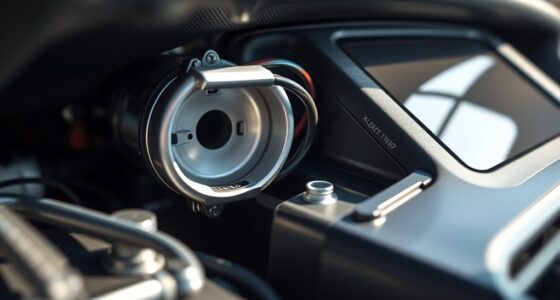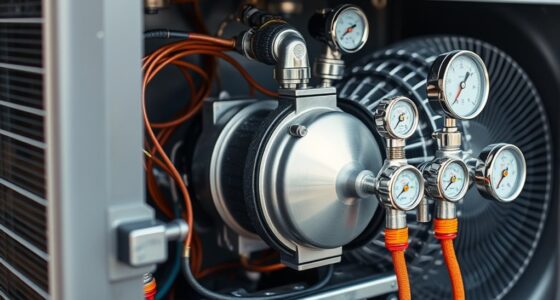If your transit automatic transmission shifts roughly or flares, start by checking the transmission fluid level and condition—low or contaminated fluid can cause these issues. Look for signs of leaks or burnt smell. Also, consider electronic controls; faulty sensors or a malfunctioning TCM might send incorrect signals, leading to rough shifts. Addressing these problems early can prevent more serious damage. Keep exploring to discover how you can identify and resolve internal causes behind the problem.
Key Takeaways
- Check transmission fluid level and condition; low or contaminated fluid often causes hard shifting or flare.
- Inspect for fluid leaks and ensure proper fluid type to maintain smooth gear engagement.
- Scan for electronic error codes to identify faulty sensors, solenoids, or Transmission Control Module issues.
- Examine internal components like clutches, bands, or solenoids for wear or damage during professional diagnosis.
- Perform regular maintenance, including fluid changes and system inspections, to prevent and address shifting problems early.

If your transit vehicle starts shifting hard or experiencing flare-ups, it can indicate underlying transmission issues that need attention. These symptoms often feel like sudden jarring when the transmission shifts gears or a noticeable surge in power followed by a loss of acceleration. Recognizing these signs early can save you from costly repairs and prevent breakdowns.
Hard shifting occurs when the transmission suddenly shifts gears with excessive force, sometimes accompanied by a clunk or jerk. Flare, on the other hand, involves the engine revving higher than usual before the transmission engages the next gear, causing a moment of acceleration that feels unsteady. Both issues can stem from a variety of causes, so it’s vital to understand what might be happening underneath.
One common reason for hard shifting or flare is low transmission fluid levels. Transmission fluid lubricates moving parts, cools the system, and helps maintain smooth gear shifts. If the fluid gets low—whether due to leaks, evaporation, or neglect—you might experience rough shifts or flares.
Checking the fluid level is straightforward; you simply need to locate the dipstick, pull it out, and verify if the fluid is at the recommended level. If it’s low, topping it off might resolve the problem temporarily, but it’s important to also identify and fix any leaks that caused the loss.
Contaminated or degraded transmission fluid can also cause shifting issues. Over time, the fluid breaks down or becomes contaminated with dirt and debris, which hampers its ability to lubricate properly. This can result in inconsistent gear engagement, leading to flare-ups or hard shifts.
Regular fluid changes as per your vehicle’s maintenance schedule can prevent this. Additionally, using the correct type of transmission fluid ensures maximum performance.
Another culprit could be worn or damaged transmission components, such as solenoids, clutches, or bands. Solenoids control the flow of fluid within the transmission, and if they malfunction, the shifts can become harsh or erratic. Similarly, worn clutches or bands may struggle to engage properly, causing flare or rough shifts.
Diagnosing these issues often requires a professional inspection, as it involves testing the transmission electronically and physically inspecting internal parts.
Finally, electronic control systems play a pivotal role in smooth shifting. Modern transmissions rely on sensors and a transmission control module (TCM) to decide when to shift gears. Faulty sensors or a malfunctioning TCM can send incorrect signals, resulting in hard shifts or flare-ups.
Diagnosing these problems involves scanning for error codes with specialized tools. Addressing electronic issues might involve replacing sensors or reprogramming the TCM.
Understanding transmission control systems and their proper functioning is crucial for diagnosing and preventing shifting problems. In essence, hard shifting or flare in your transit vehicle is a sign that something isn’t functioning as it should. Whether it’s fluid levels, internal components, or electronic controls, understanding the root cause helps you take the right steps toward repair.
Regular maintenance and prompt attention to symptoms ensure your vehicle runs smoothly, saving you time, money, and stress down the road.
Frequently Asked Questions
Can Hard Shifting Cause Permanent Transmission Damage?
Yes, hard shifting can cause permanent transmission damage if left unaddressed. When your transmission shifts abruptly or makes strange noises, it puts extra stress on internal components, leading to wear and potential failure.
Ignoring these symptoms might result in costly repairs or complete transmission failure. To avoid permanent damage, get your transmission inspected and repaired promptly whenever you notice hard shifting or other irregularities.
How Often Should I Check Transmission Fluid Levels?
You should check your transmission fluid levels at least every 30,000 miles or once a year, whichever comes first. Regular checks help you catch leaks or low fluid before they cause serious damage.
Always do it with the engine warm and running, and verify the vehicle is on a level surface.
If you notice the fluid is dark or smells burnt, it’s time for a fluid change or professional inspection.
Are There DIY Fixes for Transmission Flare Issues?
Yes, you can try some DIY fixes for transmission flare issues. Start by checking and replacing the transmission fluid if it’s dirty or low, as this often helps.
You can also clean or replace the transmission filter, and reset the transmission control module by disconnecting the battery for a few minutes.
However, if the problem persists, it’s best to consult a professional to avoid further damage.
What Are the Costs of Professional Transmission Repairs?
You’ll be thrilled to learn that professional transmission repairs can cost anywhere from $1,000 to over $4,000, depending on your vehicle and the problem’s complexity.
Expect to pay for parts, labor, and diagnostic fees. So, unless you’re enthusiastic to sell a kidney or take out a loan, brace yourself—the price tag for fixing those sneaky transmission issues isn’t exactly pocket change.
Better start saving now!
How Can I Prevent Transmission Problems in the Future?
To prevent transmission problems, you should regularly check and change your transmission fluid as recommended by your vehicle’s manual.
Avoid aggressive driving, such as rapid acceleration or abrupt braking, which puts extra stress on the transmission.
Keep an eye on warning signs like slipping or unusual noises, and address issues promptly.
Additionally, schedule routine inspections with a professional to catch potential problems early and keep your transmission running smoothly.
Conclusion
When your transit automatic transmission starts hard shifting or flaring, think of it like a warning sign flickering on your dashboard. Ignoring these signs is like ignoring a storm warning—you’re risking more damage and costly repairs. By paying attention and diagnosing the issue early, you can keep your vehicle running smoothly, like a well-oiled machine. Don’t wait for things to get worse; address transmission problems now to guarantee a safe and reliable ride.









